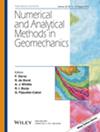Analytical Solutions for Calculating Pore‐Water Pressure and Stability of Infinite Slope With Cracks and Vegetation Under Rainfall
IF 3.6
2区 工程技术
Q2 ENGINEERING, GEOLOGICAL
International Journal for Numerical and Analytical Methods in Geomechanics
Pub Date : 2025-06-17
DOI:10.1002/nag.4019
引用次数: 0
Abstract
The presence of desiccation cracks can affect rainfall‐induced slope stability through both hydraulic and mechanical ways. Despite the valuable insights gained from physical tests in literature, there still lacks understanding how crack characteristics impact water flow dynamics and slope stability, especially considering the coexistence of vegetation. In this study, new analytical solutions were derived for calculating pore‐water pressure and slope stability for an infinite unsaturated slope with cracks and vegetation. Both enhanced infiltration from water‐filled cracks and water uptake by plant roots are considered. Using the newly developed solutions, two series of parametric analyses were carried out to improve understanding of the factors affecting crack water infiltration and hence the stability of vegetated slope. The calculated results show that slope failure at shallow depths is governed by the surface crack ratio, whereas deeper failures typically occur with greater crack depths. The surface crack ratio primarily influences the hydraulic response at shallow depths not exceeding 1.5 m, hence affecting the factor of safety for slip surfaces within the crack zone. Moreover, increasing the crack‐to‐root depth ratio from 0.5 to 1.5 results in a 25% reduction in suction at 1.5 m, threatening slope safety in deeper depth after 10‐year rainfall.降雨条件下带裂缝和植被的无限边坡孔隙水压力和稳定性的解析解
干燥裂缝的存在可以通过水力和机械两种方式影响降雨引起的边坡稳定。尽管文献中的物理试验获得了有价值的见解,但对于裂缝特征如何影响水流动力学和边坡稳定性,特别是在考虑植被共存的情况下,仍然缺乏了解。本文推导了具有裂缝和植被的无限非饱和边坡孔隙水压力和边坡稳定性的解析解。同时考虑了来自充满水的裂缝的增强入渗和植物根系的吸水。利用新开发的解,进行了两组参数分析,以提高对裂缝水入渗影响因素的认识,从而提高对植被边坡稳定性的认识。计算结果表明,边坡浅层破坏主要受地表裂缝比的控制,而深层破坏主要受地表裂缝深度的影响。表面裂缝率主要影响不超过1.5 m的浅深度处的水力响应,从而影响裂缝区域内滑移面的安全系数。此外,将裂缝与根系深度之比从0.5增加到1.5,会导致1.5 m处吸力降低25%,在10年降雨后,会威胁到更深深度的边坡安全。
本文章由计算机程序翻译,如有差异,请以英文原文为准。
求助全文
约1分钟内获得全文
求助全文
来源期刊
CiteScore
6.40
自引率
12.50%
发文量
160
审稿时长
9 months
期刊介绍:
The journal welcomes manuscripts that substantially contribute to the understanding of the complex mechanical behaviour of geomaterials (soils, rocks, concrete, ice, snow, and powders), through innovative experimental techniques, and/or through the development of novel numerical or hybrid experimental/numerical modelling concepts in geomechanics. Topics of interest include instabilities and localization, interface and surface phenomena, fracture and failure, multi-physics and other time-dependent phenomena, micromechanics and multi-scale methods, and inverse analysis and stochastic methods. Papers related to energy and environmental issues are particularly welcome. The illustration of the proposed methods and techniques to engineering problems is encouraged. However, manuscripts dealing with applications of existing methods, or proposing incremental improvements to existing methods – in particular marginal extensions of existing analytical solutions or numerical methods – will not be considered for review.

 求助内容:
求助内容: 应助结果提醒方式:
应助结果提醒方式:


